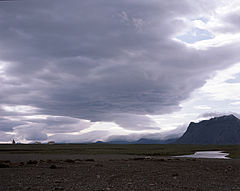Staðarsveit
| Staðarsveit | ||
|---|---|---|
|
|
||
| Coordinates | 64 ° 49 ′ N , 23 ° 9 ′ W | |
| Basic data | ||
| Country | Iceland | |
| Vesturland | ||
| ISO 3166-2 | IS-3 | |
| local community | Snæfellsbær | |
|
Bjarnafoss waterfall near Kálfavellir in Staðarsveit
|
||
Staðarsveit is a former rural parish in Iceland . The parish has now been absorbed as such in Snæfellsbær parish . On the other hand, the term is still very common as a name for the region.
location
The former municipality is located in the south of the Snæfellsnes peninsula between the Vegamot rest house and the Öxi mountain .
history
The congregation had actually developed from a parish that was related to the Staðarstaður rectory . This can look back on a long tradition.
Rich yard
There are quite a number of parishes in Iceland called Staður. The Staðarstaður farm was initially called Staður á Ölduhrygg and was considered a very wealthy farm because it was able to benefit from many additional sources of income, such as fishing, eiderdown or seal hunting due to its proximity to the sea. As a result, the pastor's position was coveted and famous men held the office of pastor here.
Ari the scholar
In the Middle Ages, for example, the scholar Ari Þorgilsson , or "Ari the scholar" (Isl. Ari froði ), who wrote the first scientific treatise on the history of Iceland, the Book of Icelandic people lived here .
In 1981 a monument was erected in his honor in Staðarstaður, which unveiled the then President of Iceland, Vigdís Finnbogadóttir . The artist Ragnar Kjartansson , who created the monument, himself came from Staðarstaður, where his father had been a pastor.
The Sturlunger
The court was temporarily under the family of the Sturlunger . Here sat Þórður Sturluson , the brother of Snorri Sturluson and his nephew, Sturla Þórðarson (1214-1284). Sturla wrote several historical works and the Sturlunga saga .
Milestone for a bishop's career
Four of the priests in this court later became bishops.
The first was Marteinn Einarsson (d. 1576), who was bishop in Skálholt from 1549 to 1558 . He was particularly known for his arguments with Jón Arason , the then bishop of Hólar .
Halldór Brynjólfsson (1692–1752) became bishop in Hólar in 1746. He suggested setting up a school in Snæfellsnes.
Gísli Magnússon (1712–1779) was also bishop in Hólar. He worked there from 1755 to 1779. He owes the church there that still exists, which is considered one of the most beautiful churches in Iceland.
The last of these bishops, Pétur Pétursson (1808-1891), was known for his political work. He was bishop of all of Iceland from 1866 to 1889.
Another Icelandic bishop, Hallgrímur Sveinsson (1841–1909), grew up in Staðarstaður, where his father was a pastor. He himself was Bishop of Iceland from 1889 to 1908.
Mineral springs
As in some other places on the Snæfellsnes peninsula, there are some mineral springs at Ölkelda I-III . The Icelandic word ölkelda also means mineral spring in German .
There are other mineral springs near Lýsuhóll .
Staðarsveit in literature
The name Staðarsveit is associated with well-known folk legend figures. At the time of the conquest, the wife of one of the first settlers, a certain gezeigturiður , is said to have been too hospitable to male travelers, which led to the first divorce in Iceland.
At the turn of the 18th and 19th centuries, the notorious magician Galdra-Loftur is said to have literally been taken by the devil here on the sea.
The Nobel laureate Halldór Laxness settled his novel " Am Gletscher " (Isl. Kristnihald undir jökli ) here.
Lýsuskarð volcanic system
The mountains bordering Staðarsveit to the north belong to the Lýsuskarð volcanic system .
The central volcano is Helgrindur .
We only know of two volcanic eruptions that occurred after the Ice Age, i. H. have taken place in this system over the past 10,000 years. However, you cannot date them exactly.
The Elliðahamar mountain range was considered a traffic obstacle in earlier times. Especially in winter there were fatal accidents on the former sea cliffs, past which roads led to the north of the peninsula.
See also
literature
- Iceland Atlas. Your key to the country and its people. A comprehensive road and travel guide (= German version of the Vegahandbókin)
- Einar H. Kjartansson: Lýsing Snæfellsness frá Löngufjörum að Ólafsvíkurenni. Ferðafélag Íslands, árbók 1982. 1982


